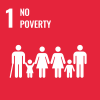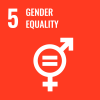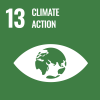
 Introduction
Introduction
We are living in an era of unprecedented population growth. Since the middle of the twentieth century, the world’s population has more than tripled in size, reaching almost 8 billion people in 2022 (figure 1). Projections by the United Nations suggest that the size of the global population could grow to almost 11 billion by around 2100. However, the pace of global growth has slowed considerably since around 1970, and the world’s population is expected to stabilize by the end of the century. 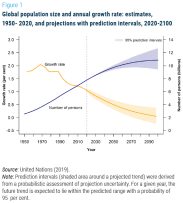 The unprecedented growth of the global population that has occurred since 1950 is the result of two trends: on the one hand, the gradual increase in average human longevity due to widespread improvements in public health, nutrition, personal hygiene and medicine, and on the other hand, the persistence of high levels of fertility in many countries. The world’s poorest countries have some of the fastest growing populations: the population of low-income countries, located mostly in sub-Saharan Africa, is projected almost to double in size between 2020 and 2050, accounting for most of the global increase expected by the end of the century.
The unprecedented growth of the global population that has occurred since 1950 is the result of two trends: on the one hand, the gradual increase in average human longevity due to widespread improvements in public health, nutrition, personal hygiene and medicine, and on the other hand, the persistence of high levels of fertility in many countries. The world’s poorest countries have some of the fastest growing populations: the population of low-income countries, located mostly in sub-Saharan Africa, is projected almost to double in size between 2020 and 2050, accounting for most of the global increase expected by the end of the century.
Population growth is both a cause and a symptom of slow progress in development
Sustained, rapid population growth adds to the challenge of achieving social and economic development and magnifies the scale of the investments and effort required to ensure that no one is left behind. Rapid population growth makes it more difficult for low-income and lower-middle-income countries to afford the increase in public expenditures on a per capita basis that is needed to eradicate poverty, end hunger and malnutrition, and ensure universal access to health care, education and other essential services. Lack of autonomy and opportunity among women and girls can contribute to high fertility and rapid population growth. Achieving the Sustainable Development Goals (SDGs) of the 2030 Agenda for Sustainable Development, especially targets related to reproductive health, education and gender equality, requires empowering individuals to make informed choices.  Today, millions of people around the globe, mostly in low-income and lower-middle-income countries, lack access to the information and services needed to determine whether and when to have children. In general, women with higher levels of education tend to have greater autonomy to make these decisions compared to women with no education living in the same country (figure 2). Ensuring that individuals, in particular women, have the ability to decide the number of children that they will have and the timing of their births can markedly improve well-being and help to disrupt intergenerational cycles of poverty. Increased access to high quality reproductive health-care services, including for safe and effective methods of family planning, could help reduce fertility and accelerate economic and social development.
Today, millions of people around the globe, mostly in low-income and lower-middle-income countries, lack access to the information and services needed to determine whether and when to have children. In general, women with higher levels of education tend to have greater autonomy to make these decisions compared to women with no education living in the same country (figure 2). Ensuring that individuals, in particular women, have the ability to decide the number of children that they will have and the timing of their births can markedly improve well-being and help to disrupt intergenerational cycles of poverty. Increased access to high quality reproductive health-care services, including for safe and effective methods of family planning, could help reduce fertility and accelerate economic and social development.
A sustained reduction in fertility opens a window of opportunity for economic growth
In addition to driving rapid population growth, continuing high levels of fertility in some regions have helped to maintain a relatively youthful global age distribution. 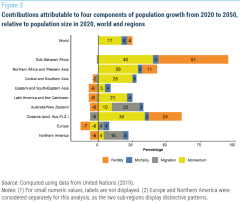 From a demographic perspective, a youthful age structure ensures that the global population will continue to grow even if average fertility drops immediately to the “replacement level”, at which each generation bears the exact number of children needed to replace itself. Indeed, fully two thirds of the anticipated increase in global population between 2020 and 2050 will be driven by the momentum of growth embedded in the relatively youthful age distribution of the world’s population in 2020 (figure 3). A youthful population presents an opportunity for accelerated economic growth on a per capita basis, if countries where the population is growing rapidly achieve a substantial and sustained decline in the fertility level, leading to an increased concentration of the population in the working-age range. The increased share of population in the working ages can support an accelerated rise in income per capita, a phenomenon referred to as the “demographic dividend”.
From a demographic perspective, a youthful age structure ensures that the global population will continue to grow even if average fertility drops immediately to the “replacement level”, at which each generation bears the exact number of children needed to replace itself. Indeed, fully two thirds of the anticipated increase in global population between 2020 and 2050 will be driven by the momentum of growth embedded in the relatively youthful age distribution of the world’s population in 2020 (figure 3). A youthful population presents an opportunity for accelerated economic growth on a per capita basis, if countries where the population is growing rapidly achieve a substantial and sustained decline in the fertility level, leading to an increased concentration of the population in the working-age range. The increased share of population in the working ages can support an accelerated rise in income per capita, a phenomenon referred to as the “demographic dividend”.  Investments in education and health and the promotion of full and productive employment for all, including for women, can greatly expand the positive economic impact of a favourable age structure created by a sustained decline in fertility. However, many countries that are ready demographically to benefit from the dividend lag in these critical investments (figure 4).
Investments in education and health and the promotion of full and productive employment for all, including for women, can greatly expand the positive economic impact of a favourable age structure created by a sustained decline in fertility. However, many countries that are ready demographically to benefit from the dividend lag in these critical investments (figure 4).
Changes in population trends alone will do little to resolve unsustainable patterns of resource use
Environmental damage often arises from economic processes that lead to higher standards of living for the population, especially when the full social and environmental costs, such as damage from pollution, are not factored into economic decisions about production and consumption. 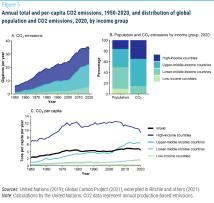 Population growth amplifies such pressures by adding to total economic demand. However, the countries that have been contributing the most to unsustainable patterns of production and consumption are generally those where income per capita is high and the population is growing slowly if at all, not those where income per capita is low and the population is growing rapidly (figure 5). Moving the global economy towards greater sustainability will require a progressive decoupling of the growth in population and in economic activity from a further intensification of resource extraction, waste generation and environmental damage. Limiting climate change and global warming, for example, will require rapid progress in decoupling economic activity from the current overreliance on fossil fuels. To end poverty and hunger, achieve the SDGs related to health, education and access to decent work, and build the capacity to address environmental challenges, the economies of low-income and lower-middle-income countries need to grow much more rapidly than their populations, requiring greatly expanded investments in infrastructure as well as increased access to affordable energy and modern technology in all sectors. Wealthy countries and the international community can help to ensure that these countries receive the necessary technical and financial assistance so that their economies can grow using technologies that will minimize future greenhouse gas emissions. A path towards a more sustainable future requires demographic foresight, which involves anticipating the nature and consequences of major population shifts before and while they occur and adopting forward-looking and proactive planning guided by such analysis. In working to achieve sustainable patterns of consumption and production and to reduce the impacts of human activity on the environment, it is important to recognize that plausible future trajectories of world population lie within a relatively narrow range, especially in the short or medium term. Over the next 30 or 40 years, a slowdown in global population growth that is substantially faster than anticipated in the United Nations projections seems highly unlikely. Even though the pace of global population growth will continue to decline in the coming decades, world population is likely to be between 20 and 30 per cent larger in 2050 than in 2020. Achieving sustainability, therefore, will depend critically on humanity’s capacity and willingness to increase resource efficiency in consumption and production and to decouple economic growth from damage to the environment, with high-income and upper-middle-income countries taking responsibility and leading by example.
Population growth amplifies such pressures by adding to total economic demand. However, the countries that have been contributing the most to unsustainable patterns of production and consumption are generally those where income per capita is high and the population is growing slowly if at all, not those where income per capita is low and the population is growing rapidly (figure 5). Moving the global economy towards greater sustainability will require a progressive decoupling of the growth in population and in economic activity from a further intensification of resource extraction, waste generation and environmental damage. Limiting climate change and global warming, for example, will require rapid progress in decoupling economic activity from the current overreliance on fossil fuels. To end poverty and hunger, achieve the SDGs related to health, education and access to decent work, and build the capacity to address environmental challenges, the economies of low-income and lower-middle-income countries need to grow much more rapidly than their populations, requiring greatly expanded investments in infrastructure as well as increased access to affordable energy and modern technology in all sectors. Wealthy countries and the international community can help to ensure that these countries receive the necessary technical and financial assistance so that their economies can grow using technologies that will minimize future greenhouse gas emissions. A path towards a more sustainable future requires demographic foresight, which involves anticipating the nature and consequences of major population shifts before and while they occur and adopting forward-looking and proactive planning guided by such analysis. In working to achieve sustainable patterns of consumption and production and to reduce the impacts of human activity on the environment, it is important to recognize that plausible future trajectories of world population lie within a relatively narrow range, especially in the short or medium term. Over the next 30 or 40 years, a slowdown in global population growth that is substantially faster than anticipated in the United Nations projections seems highly unlikely. Even though the pace of global population growth will continue to decline in the coming decades, world population is likely to be between 20 and 30 per cent larger in 2050 than in 2020. Achieving sustainability, therefore, will depend critically on humanity’s capacity and willingness to increase resource efficiency in consumption and production and to decouple economic growth from damage to the environment, with high-income and upper-middle-income countries taking responsibility and leading by example.
References
Global Carbon Project (2021). Supplemental data of Global Carbon Budget 2021 (Version 1.0) Dataset. Available at https://icos-cp.eu/science-andimpact/global-carbon-budget/2021. Ritchie, Hannah, and others (2021). Our World in Data. CO2 and Greenhouse Gas Emissions dataset. Available at https://github.com/owid/co2-data Accessed on 7 November 2021. United Nations (2019). World Population Prospects 2019, Online Edition. Available at https://population.un.org/wpp/. Accessed on 15 October 2020. United Nations (2020). SDG Indicators Global Database. Available at https://unstats.un.org/sdgs/indicators/database/. Accessed on 15 June 2020. United Nations Educational, Scientific and Cultural Organization (UNESCO) (2020). Sustainable Development Goals 1 and 4. Available at http://data.uis.unesco.org/. Accessed on 1 July 2020.
 Welcome to the United Nations
Welcome to the United Nations
